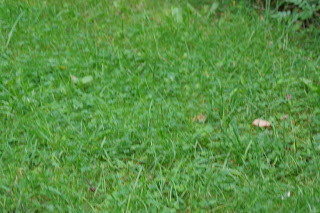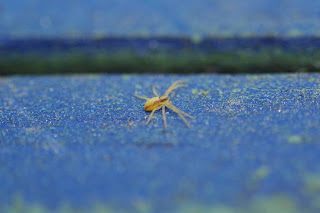No Backyard Bug of the Day today, but I do have an interesting encounter between insects to share:
Beetle on aster, and creeping onto the flower is a stilt bug. I always thought that stilt bugs fed on plants, but one day I saw one feeding on another bug. Looking them up, though, they mainly do feed on plants. So, seeing this stilt bug cautiously approaching, I wondered what would happen when the two met. Would they share the flower and feed on it? Or would this be one of those times when a stilt bug feeds on an insect?
At first, it seemed like the beetle didn't want to find out.
But it came back, at one point walking all over the stilt bug's antennae, which are very long. The stilt bug moved forward sooooooo sloooooooowly.
Then, suddenly, the beetle decided not to stick around and find out what the stilt bug's intentions were, and scurried off. I sometimes wonder how much other bugs know about what other bugs are harmless to them, and which ones will eat them. I often see bugs of different species feeding together on the same flowers without concern. But I also often see bugs that have been snatched by other bugs on those flowers. Did they not see them? Did they see them and not comprehend the danger? I can't get within ten feet of some bugs without them flying away, how much danger do they sense from other insects?
I don't have any idea.
Other Bugs:
Assassin bug on aster. Undoubtedly if the beetle had met this bug instead of the stilt bug it would have been preyed upon. I like it when I can show you the adult and nymph stages of the same insect species together. Here is the nymph of the assassin bug species above:
Robber fly feeding on a tiny leaf hopper. I did not notice the other leaf hopper on the branch until the robber fly flew away. This is a female robber fly, and that is not a stinger, it is an ovipositor. She was using it to probe the branch. I can't tell if she was laying eggs or not.
After it flew away from the branch, it did not go far. It landed on my monopod:
I had to take my camera off the monopod to take these pictures.
I saw this bee delving into a flower on the thistle plant that had gone to seed. There are other flowers on the plant that are blooming, so I don't know why the bee was interested in the one that has finished blooming, which I would assume is no longer producing nectar or pollen. Is there something else the plant produces that the bee wanted?
I took bad photographs of three different species of dragonflies today:
I couldn't get close enough to this one for a good picture.
I couldn't get close to this one, either, but I am sure you can see the other problem with getting a good picture of it.
I am taking a paleontology class, and the chapter I am reading about currently mentions cryptic adaptations, which are features of animals that make them difficult to detect. This can be useful for prey, so that they can avoid being eaten, but also for predators, because it can help them to catch prey unawares. I should mention that they don't know if dinosaurs had cryptic adaptations because they are the kinds of features that don't fossilize, like skin color. This dragonfly sure seems cryptic to me, but I am not sure if that really helps it as a predator, because of the way dragonflies hunt. But maybe it does.
Closer look.
And this one, well...
Dragonflies sometimes patrol an area, flying back and forth over the same space many times. This dragonfly was patrolling a complicated intersection of paths in my backyard. I watched it for over five minutes, and did not see it land anywhere. It would react to my presence at first by shifting to a new path when I got too close, but eventually it decided just to fly over me like I was a hurdle in the path. It was patrolling low to the ground, except when it went over my head (which I found kind of amusing, because it seems like it would have been easier just to go around me).
And now for a story about a spider. A few days ago I woke up to my alarm clock, and the first thing I saw when I opened my eyes was a jumping spider on the wall in front of me, about two feet away. As much as I love jumping spiders, I found this unnerving. I grabbed a tissue and tried to gently capture the spider so I could put it outside, but the spider escaped. I was not happy about this, because, well, that's just too close to where I sleep for me to know there is a jumping spider. But there wasn't anything I could do about it. I had to get on with my morning. Well, last night I was reading in bed, and suddenly a jumping spider, the same one, I hope, because I would not like there to be more of them, suddenly appeared on the edge of the mattress, very close to my pillow. This just won't do. I can't have a spider crawling around my pillow, so once again I grabbed a tissue. For a brief moment I was determined just to kill the spider, as it was somewhat troublesome, but I couldn't bring myself to do it, so instead I once again tried to gently capture it. Once again I failed, and the spider fled down the side of the mattress, right by the spot where I was planning to lay down my head to sleep in a few minutes. I looked over the edge of the mattress. No spider. I had no idea where it went. How, I thought, is it possible for me to go to sleep now? And yet, I went back to my reading, and a few minutes later when I was too tired to read on, I put aside my book and turned out the light, and somehow did not entertain a single thought about the spider lurking somewhere near my pillow. Had I thought about it, I am sure I would have been uneasy, but... I didn't. I have so many other worries in my mind, maybe they chased the spider out of it. I have not seen it today, and I don't want to, not near my pillow, anyway. Arachnid Appreciation:
.
.
.
.
.
.
.
.
.
.
.
.
A friend of mine once posted a meme on facebook saying something along the lines of, with all the terrible things in the world, at least we have this comfort: that spiders can't fly. I felt compelled to reply that, well, they sort of can. This answer was not received with any kind of welcome. This spiderling dropped out of the sky and landed on my hand while I was sitting at the picnic table. Well, it's thread landed on my hand, and the spider dangled from it until I lowered it to the table. I was not sitting under a tree, so it didn't just lower itself down. When spiderlings hatch, there are a lot of them all together, and thus they need to spread out, and it is best, of course, that they disperse far away from each other. So they will spin out a thread of silk, and use it to sail away into the air on the wind. They can travel pretty far this way, which disperses the hatchlings quite nicely. That is probably where this spiderling came from, wafting in on the breeze as it struck out on its own into the world.



















No comments:
Post a Comment